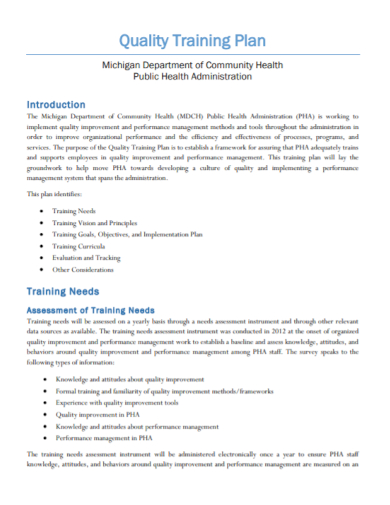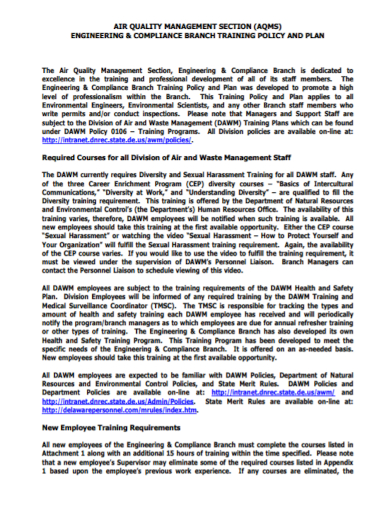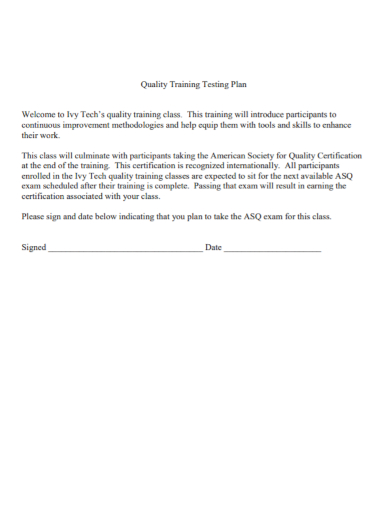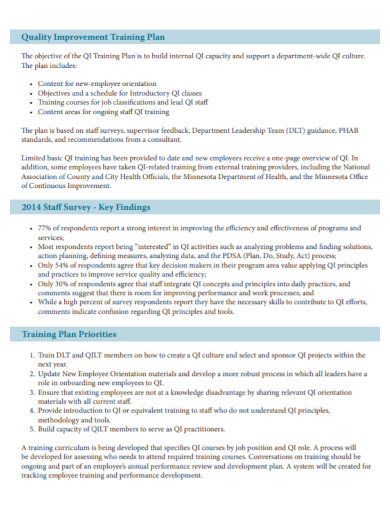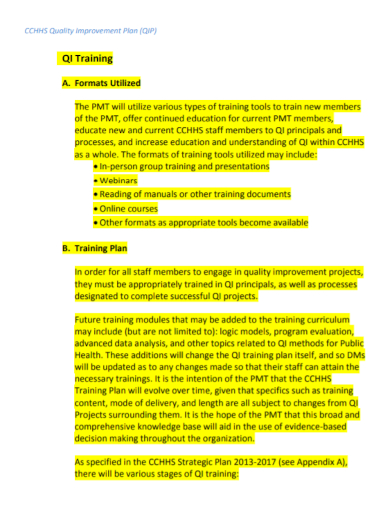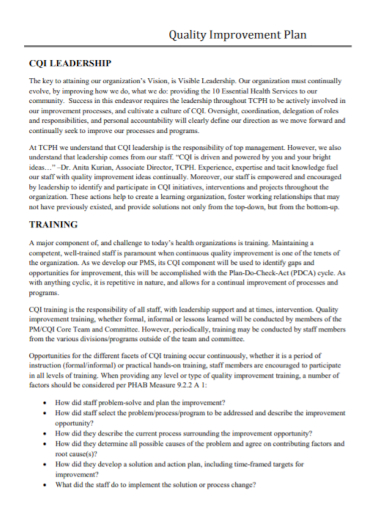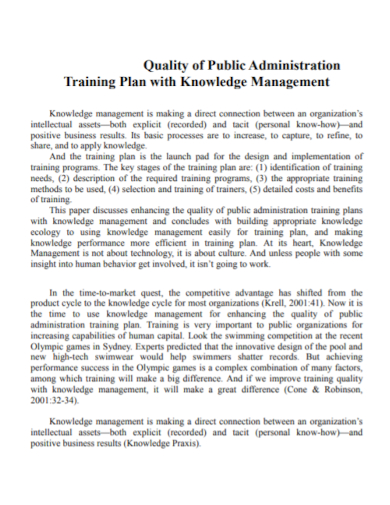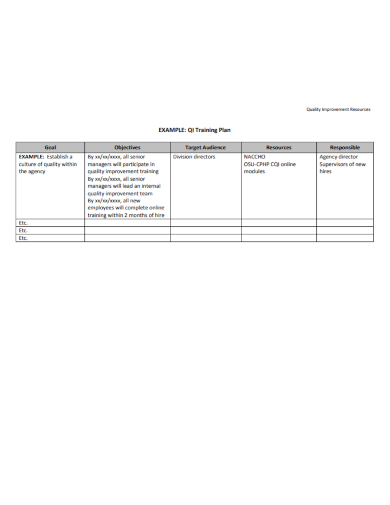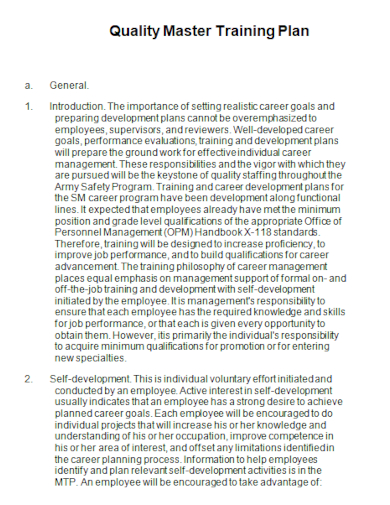Quality work means that employees in organizations consistently achieve expectations while simultaneously having positive and ethical working practices. To deliver quality work means putting your best foot forward to ensure that the goals of the organization will be achieved and at the same time proving yourself and your employers that you are an efficient employee. However, not all employees can deliver quality work due to a lack of guidance from their employers. By providing a quality training plan for them can orient and teach them to identify their shortcomings and show them how to improve their work methods and ethic. Read the article to find out how to make a quality training plan.
8+ Quality Training Plan Samples
1. Quality Training Plan
2. Quality Engineering Training Plan
3. Quality Training Testing Plan
4. Quality Improvement Training Plan
5. Printable Quality Improvement Training Plan
6. Quality Leadership Improvement Training Plan
7. Quality Management Training Plan
8. Quality Improvement Resources Training Plan
9. Quality Master Training Plan
What is Quality Training Plan?
A quality training plan is a thought-out plan to train employees to improve their quality of work. Well-trained employees develop a positive attitude toward their work resulting in a stronger work ethic and increase the production rate. Employees also develop team spirit and leadership skills that help the work environment become positive and healthy for employees.
How to Make a Quality Training Plan
1. Analyze Training Needs
Identifying and assessing needs is the first stage in building a training program. Employee training requirements may already be specified in the company’s strategic, human resource, or individual development plans. If you’re starting from scratch you’ll need to figure out which areas to work on.
2. Establish Training Goals
Any gaps in your present training activities and employee skill sets will be identified through the training needs assessments. These gaps should be identified, prioritized, and made into training goals for the organization. The ultimate goal is to construct a training program that will bridge the gap between present and desired performance. Employee training should be customized to the areas in which they need to improve.
3. Develop Targeted Content
The next step is to create a comprehensive action plan that includes learning theories, instructional design, content, materials, and other training components. It’s also a good idea to add resources and training delivery techniques. The level of training and the learning styles of the participants should both be addressed while constructing the program. Many businesses run pilots of their projects and obtain feedback before launching the program to the rest of the company.
4. Monitoring, Evaluating, and Tracking Results
The training curriculum unfolds during the implementation phase. Organizations must choose whether training will be given in-house or through a third-party provider. Employee engagement and learning KPI goals should be considered during program execution, as well as meticulous preparation of training activities and resources. After that, the training program is formally launched, marketed, and conducted. Participants’ progress should be observed during training to ensure that the program is effective.
5. Analyze and Revise Training
All participants should provide feedback to determine the effectiveness of the program and instructors, as well as knowledge or skill acquisition. By combining this input with an employee performance review, the company will be able to detect any program flaws. If targets or expectations are unfulfilled, the training program or action plan might be altered at this time.
FAQs
What are the five types of training?
The five types of training are orientation, onboarding, technical skills development, soft skills development, products and services training, quality training, safety training, and team training.
What are principles of training?
The principles of training are overload, reversibility, progression, individualization, periodization, and specificity.
What are the seven quality management principles?
The seven quality management principles are the engagement of people, customer focus, leadership, process approach, improvement, evidence-based decision making, and relationship management.
Writing an action plan might seem daunting but it’s worth the effort to keep yourself focused on achieving your goals and give you clarity. Make sure to review it first before presenting it and revise it to get rid of grammatical and spelling errors, incoherent sentences, and adjust the tone of the action plan if needed. Present it to your co-workers and ask for suggestions and listen to their opinions to check if the action plan needed to be changed a bit to include some steps to be taken for quality training. If you want to get started on making your own quality action plan, download our free sample templates as your reference!
Related Posts
FREE 10+ Higher Education Lesson Plan Samples in MS Word | Pages | Google Docs | PDF
FREE 9+ 30-Day Marketing Plan Samples in PDF | MS Word | Apple Pages | Google Docs
FREE 3+ Sales Team Action Plan Samples in PDF | MS Word | Apple Pages | Google Docs
Marketing Plan For Small Business Samples
FREE 7+ Fashion Business Plan Samples in PDF
FREE 10+ Sprint Planning Samples In MS Word | Google Docs | PDF
FREE 10+ Wedding Planning Samples in MS Word | Apple Pages | Powerpoint | PDF
FREE 9+ Monthly Study Planner Samples in PSD | Illustrator | InDesign | PDF
FREE 9+ Sample Curriculum Planning Templates in PDF | MS Word
FREE 10+ Teacher Development Plan Samples in MS Word | Google Docs | Apple Pages | PDF
FREE 10+ Basketball Practice Plan Samples in PDF
FREE 12+ School Business Plan Samples in PDF | MS Word | Apple Pages | Google Docs
FREE 7+ Client Strategic Plan Samples in PDF | MS Word
FREE 11+ Trucking Business Plan Templates in PDF | MS Word | Google Docs | Pages
FREE 7+ Small Hotel Business Plan Samples PDF | MS Word | Apple Pages | Google Docs

